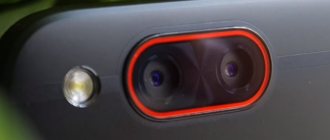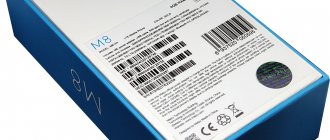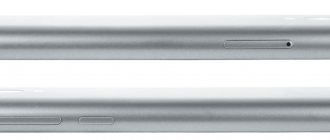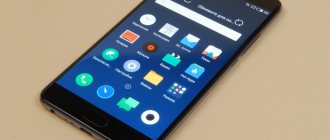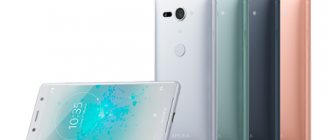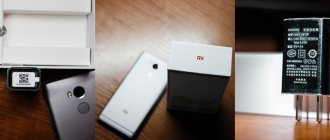Equipment
When I was handed a regular-sized “small package” at the post office, I sincerely doubted that the M3 mini I was expecting was inside. And is there even a smartphone inside? The thing is that the parcel was very modest in size. It turned out that the box for the M3 mini was quite miniature. The dimensions are similar to the packaging from the iPhone 4 or 4S.
Inside the box there was a power supply (5V, 1.5A), a Micro USB cable and a SIM card ejector with a proprietary Flyme cloud.
The device came to me from this store. The seller was not generous with either the protective film or the silicone case. Inside the package there was only an adapter for our sockets. In any case, I did not ask the seller for any bonuses. This is probably my mistake.
Design
Meizu M3 mini is the official name of the smartphone for foreign markets, including Russia. In China, this model is simply called M3, without any prefixes. Further in the text I will use both model names - we will always talk about the same device.
There is also the M3 Note, which is equipped with a 5.5-inch screen, which means it is a larger device, as indicated by the corresponding console. However, let's return to our hero.
Due to the smaller diagonal display (5 inches), the device was designated as a mini-version of its older brother. In addition, the resolution has also been reduced from Full HD to regular HD resolution or 1280 x 720 pixels. Accordingly, it is better to compare the device with its predecessor, which is what we will do as we review the M3 mini .
In terms of design, the new product has noticeably refreshed. The plastic and slightly protruding edge of the screen was removed. And the protective glass became rounded at the edges. It is clear that the smartphone has sparkled with new colors and now it is very much reminiscent of the iPhone 6. True, it is slightly plumper (6.9 for the Apple versus 8.3 mm for our hero), plastic and with an elongated, rather than round, button under the screen. And the camera doesn’t protrude, but more on that later.
The glass of the M2 mini had an oleophobic coating, but the quality was different from that of the M3. The latter received truly flagship glass protection against fingerprints.
Below the display is the pride of most Meizu devices - the mBack touch key. You can click on it (the default action is “Home”), or simply touch it (the action “Back”). Holding calls up the voice assistant, but this same function can be used to lock the smartphone. By default, this cannot be done, but here are instructions on how to finish this feature yourself.
Sensitivity and touch recognition are excellent. The last open applications are called very simply - there is no key involved. Just swipe your finger from the very bottom edge of the screen and the multitasking curtain will pop up behind it. Again, it works perfectly, there are no misses.
Of course, there is automatic brightness adjustment and a distance sensor. Both work well, but the first one still could use a little more efficiency.
Not much has changed at the rear compared to the previous model. The same large camera eye, rolled up flush with the body. Below is the brand name and that’s it. Minimalism is very pleasant, so there’s no need to get fancy here. It's good that the manufacturer understands this.
At the bottom there are symmetrical holes for a microphone and a multimedia speaker (to the right of the Micro USB port). Sound quality is average. In the previous generation, the speaker was very bad, here it seems to be a different speaker, the quality has improved. The volume is average, on a noisy street you might miss a call.
At the top there is a connector for connecting external speakers or headphones. There is nothing unusual about it.
The SIM card tray is located on the left side. One slot for Nano SIM, the second for either the same SIM card or Micro SD. It would be great if all manufacturers began to slowly switch to combined trays, but so far this trend is far from widespread. The few exceptions I've tested are the Cubot S600 and the Bluboo XTouch.
The plastic in the case is the most common. It is pleasant to the touch (not Soft Touch), moderately slippery. Due to its small dimensions, the M3 mini fits perfectly in the hand and is a pleasure to work with: your fingers can reach any part of the screen. For many, this is one of the key parameters when choosing a phone, and I have no doubt that the new product will be very successful in sales, like the previous generation.
There are four colors available in the market. Each one looks very interesting, original, there is nothing repulsive about the colors.
While this device was on its way to me, Meizu managed to present its updated, improved and, most importantly, international version - M3S mini. This device has a metal body and a fingerprint scanner. It is clear that for the improved brother they are asking a little more money - 100 Chinese yuan or about 12 dollars.
Design and ergonomics
The review of meizu m3 mini should start with the appearance, which will not offer the buyer anything fundamentally new, but at the same time the phone does not look outdated or unfashionable. The M3 mini is a small device by modern standards with a metal cover on the back and plastic inserts on the top and bottom.
The front panel has 2.5D glass, which improves ergonomics - the phone fits perfectly in the hand and even with a metal case does not slip. The display is covered with glass and has a high-quality oleophobic coating. It was missing in previous smartphones and the fact that it is present should be considered a clear plus.
On the front panel at the bottom there is a proprietary physical mTouch button. It performs several functions at once and replaces the classic trio of touch buttons on other Android phones. The manufacturer also installed a fingerprint scanner in it.
According to reviews, the latter works quickly and makes almost no mistakes. Above the screen there is a speaker mesh, a camera and proximity and light sensors. Unlike many devices, the manufacturer painted not only the back cover, but also the side edges. In this way, only the face stands out; it is painted white, regardless of the main color.
At the bottom end there is the main speaker and an input for connecting charging. The top end received a headset output. On the right side is the power button and volume control. The combo slot is located on the left. It opens with a paperclip. From this point of view, the manufacturer does not offer any innovations. The back panel is also quite familiar - there is a camera and a double flash at the top. Plastic inserts provide high-quality communication.
The assembly of the model is at a very high level, the transition point from plastic to metal does not play or creak. In general, when working with the phone you don’t get the feeling that it’s cheap. The choice of colors is quite wide. There are also men's options - gray and dark gray, as well as two women's models - pink and gold. All of them are available for purchase in Russia. All options turned out to be not easily soiled, so the presence of a protective cover is a matter of personal preference. There is no particular need for it, but do not forget that the metal case tends to wear out and this is best seen on gold.
In some Meizu smartphones from the inexpensive segment, over time, according to reviews, button play appears, but no such phenomena were noticed in this model.
Display
From a screen perspective, not much has changed here. The same IPS matrix with a resolution of 1280 x 720 pixels was installed here. With such a diagonal (5 inches) you don’t need more. Fonts look smooth and crisp, and too many pixels will only waste your processor and battery resources. Why is it needed? Moreover, in a budget device.
Viewing angles are expectedly good - at the level of most IPS panels. However, under a strong slope, criminal yellow shades creep out. This is a sign of not the most successful IPS panel. In the photo below, the Cubot Dinosaur screen (5.5 inches) is on top, and our hero is below.
In the menu you can adjust the screen temperature to suit your needs. I didn’t touch this item, I used the standard settings.
The brightness reserve is sufficient for most situations. This is why the screen remains readable in the sun. This is greatly facilitated by the absence of constantly accumulating fingerprints on the front side.
Technical characteristics of Meizu M3 mini
Considering that the M2 mini is still a relevant smartphone, and that two more updated devices have recently been added to the manufacturer’s collection, we will compare all three devices at the same time.
| Meizu M2 mini | Meizu M3 | Meizu M3s mini | |
| CPU | MediaTek MT6735 (4 Cortex-A53 cores @ 1.3 GHz, 64-bit) | MediaTek MT6750 (8 Cortex-A53 cores at 1.5 and 1 GHz, 64-bit) | |
| Video chip | Mali-T720 graphics up to 600 MHz | Mali-T860 MP2 | |
| RAM | 2 GB LPDDR3 | 2 or 3 GB LPDDR3 | |
| Built-in storage | 16 GB eMMC 5.0 | 16 or 32 GB eMMC 5.0 | |
| Memory cards | Yes, Micro SD up to 128 GB | Yes, Micro SD up to 128 GB | |
| Display | IPS, 5 inches, 1280 x 720 pixels (296 ppi), AGC Dragontrail protective glass | IPS, 5 inches, 1280 x 720 pixels (296 ppi), SCHOTT Xensation Cover glass with 2.5D effect | |
| Front-camera | 5 MP (f/2.0) | 5 MP (f/2.0) | |
| Main camera | 13 MP (f/2.2) | 13 MP (f/2.2) | |
| Battery | 2500 mAh | 2870 mAh | 3020 mAh |
| Connectors | Micro USB (OTG), 3.5 mm audio output | Micro USB (OTG), 3.5 mm audio output | |
| Sensors | Light and proximity sensor, accelerometer, digital compass, magnetic sensor | light and proximity sensor, accelerometer, gyroscope, digital compass | |
| Fingerprint's scanner | No | mTouch 2.1 (0.2 sec response speed, 360 degrees, up to 5 prints | |
| OS | Android 5.1.1 (Flyme OS 4.5 shell) | YunOS (Flyme OS 5.1 shell | Android 5.1 (Flyme OS 5.1 shell |
| Wireless capabilities | Wi-Fi (802.11 a/b/g/n Dual Band), Bluetooth 4.0 | Wi-Fi (802.11 ac, Dual Band), Bluetooth 4.0 | |
| Cellular networks | 2G, 3G, 4G | 2G, 3G, 4G (VoLTE support) | |
| SIM cards | Nano + Nano or Micro SD | ||
| Navigation | GPS, A-GPS | GPS, A-GPS, Glonass | |
| Dimensions | 140.1 x 68.9 x 8.7 mm | 141.5 x 69.5 x 8.3 mm | 141.9 x 69.9 x 8.3 mm |
| Weight | 131 g | 132 g | 138 g |
| Frame | Plastic | Metal | |
As you can see, the differences between the M2 and M3 are quite noticeable (after all, they are different generations), but there are not so many between the plastic and metal devices. And for metal, a fingerprint scanner and additional battery capacity, the user will have to pay about $12 extra. The choice seems obvious, but we’ll talk more about prices at the very end.
The interesting thing is that on the official website (Chinese) when you go to the M3 smartphone, the browser displays this.
Obviously, the device is either discontinued and will not be sold even in China, or this is some kind of mistake. Only it lasts quite a long time - the link has been inactive for a week.
Many people are concerned about the support of our native 4G networks by Chinese devices. Let me tell you, the model I tested was M3 (M688U). Its range of supported frequencies is quite large:
- TD-LTE frequencies: 1880 - 1920 / 2300 - 2400 / 2570 - 2620 / 2555 - 2655 MHz
- FDD-LTE bands: 1920 - 1980 / 1710 - 1785 / 2500 - 2570 MHz
All this means that the device will work without problems in our 4G networks. In general, I had no complaints about the quality of communication. Wi-Fi also works well over long distances.
Iron
The M3s mini runs on an 8-core MediaTek MT6750 chipset: four Cortex-A53 cores clocked at 1.5 GHz and the same at 1 GHz.
The speed of the interface is instantaneous, no freezes or slowdowns. Not all games show brilliant results, but nevertheless, many modern toys start, and the case heats up to a tolerable temperature.
The operating system is the standard Meizu solution - Android under the proprietary Flyme shell.
The smartphone will be available in two configurations: 2 GB of RAM and 16 GB of internal memory and 3 GB of RAM and 32 GB of internal memory.
There is support for memory expansion via microSD up to 128 GB. But this is only if you refuse to use two nanoSIM cards that support 4G communication.
There is also support for the following networks: Wi-Fi (ac and b/g/n/ac) dual-band Wi-Fi (2.4 GHz/5 GHz), Bluetooth 4.0, microUSB connector (USB 2.0 with OTG support) and GPS.
Performance
Let's start by discussing the interface. There are no problems in this regard. The device does not hint at its budget origins. Animation, switching between applications - everything is at a very good level, without lags or slowdowns. Under heavy load, when there are many utilities running in the background, the launch of individual applications may take an extra 3-4 seconds, but this is not at all critical. Using a smartphone is comfortable and pleasant.
Gaming performance. In Asphalt 8, medium and high graphics settings are not available. You can choose either very low or just low. I settled on the latter and, frankly speaking, the smartphone disappointed me. Even at less demanding settings, smooth animation is still a long way off. You can play, but it doesn't feel particularly comfortable.
After the latest update, Unkilled has become either simpler or less demanding on hardware. In any case, it initially launched on high settings, but playing in this situation is very difficult - the fps drops are quite large. On average graphics, the puddles on the asphalt disappeared, but you can play very comfortably - the ride is smooth always and everywhere.
World of Tanks Blitz flies at no lower than 50 frames per second. There are no problems here.
Main camera
At the back there is a 13 megapixel module with a slightly less “bright” lens - f/2.2. As for me, this is exactly the same photosensor as in the Meizu M2 mini. The output is very good quality photographs in macro mode.
Ordinary shots of the city, architecture and so on are not impressive. They're just not bad.
On the left is a shot without the HDR option, and on the right is a shot with the function enabled.
At night and in low light, the quality, of course, drops greatly, but with the right skill, out of 3-5 pictures you can get one of a very good level.
In general, for a budget smartphone, the quality of both cameras is very, very pleasant. In general, the gradation is, of course, slightly below average.
We take the originals of all photos in one archive from here.
Of course, the manufacturer has equipped its brainchild with a bunch of different shooting modes. There's even a manual mode, which is common on flagship devices or so. However, I liked the ability to shoot GIFs straight out of the box.
The maximum duration of one animation is 6 seconds, the resolution is 320 x 320. In the end, it turns out very cool, slightly reminiscent of the “live photos” in the iPhone 6S.
The device can record video with a resolution of 1920 x 1080 pixels at 30 frames per second.
Below is an example of a video shot in harsh lighting conditions (Muse concert). For some reason, the device independently decided to lower the frame rate to 20, without asking me about it.
Camcorder
The next thing that our Meizu M3 mini review will tell you about is the capabilities of the smartphone’s cameras. The resolution of the main module is 13 megapixels with phase focusing and f/2.2 aperture. The lens has Gorilla Glass 3 protection, which is certainly very good and increases the safety of the camera.
The front camera resolution is 5 megapixels. It has an f/2.0 aperture and 4 lenses. Dual LED flash available, providing warm and cool glow.
Characterizing the quality of photos obtained using the cameras of the described gadget, we can note a fairly accurate white balance and optimal dynamic range. Sharpness is quite enough. The camera focuses in the right place very quickly due to good phase detection autofocus. There are also no problems with focusing accuracy.
We know very well that the best way to test the quality of a camera is in low light conditions. And here we see the usual picture - at dusk or at night, shooting from both modules is almost impossible. There is a huge amount of noise, the image ceases to be sharp, and the white balance becomes far from reality.
But we will not criticize Meizu for this - the same problems are typical for any other smartphone in the price category up to 15 thousand rubles. Selfies from the front module are not very wide-angle, although not bad.
The maximum quality of video recording during the day is up to 30 frames per second, at night - up to 20 frames. The picture and focus are at an average level. But there are no complaints about the sound: it is quite intelligible and understandable. The front camera can record video in up to FullHD format, so this will be quite enough for vlog lovers.
Setting shutter speed, focus, exposure and ISO is possible in manual mode. The rest of the settings remain the same, nothing new here.
Software shell
Let's move on to software, because in this case this issue is one of the most pressing. And all because it is directly related to price. In official deliveries (we will sell the M3s mini version), the device will cost quite a lot of money (the price has not yet been announced) and has little correlation with the budget category of devices, in which the manufacturer is present in its own market, that is, in China.
Its plastic version in terms of domestic currency costs almost half as much - 6,100 rubles.
However, it has a significant limitation - the lack of localization. Fortunately, this issue can be resolved very simply - by installing third-party, Russified firmware according to the full program. The seller can do this for you if you ask him to do so. This was the case in my case - the device arrived to me Russified and with YunOS 3.1.6 installed.
There is another misconception floating around on the Internet, allegedly YunOS is not an operating system, but guess what, it was created specifically for the Chinese market and may not be compatible with Android applications at all. However, none of this is true.
In my case (again, thanks to the seller), Google services were already pre-installed with all the ensuing consequences. The account is synchronized, applications are installed and, best of all, they work as normal. Instagram alone is incredibly stupid when you try to view the feed of recommended photos. Otherwise, everything works the same as on any Android device.
Important note: Google Play Market will not work correctly without a SIM card inserted into the device.
You only need to use mobile Internet. This is a feature of the initial activation of services from the Internet giant. After this, you can easily download applications via Wi-Fi.
Another point that some users face is how to download applications from the Market via cellular communication. To do this, you need to go to the separate “Downloads” application and allow this operation in its settings.
On top of this Android or YunOS, of course, is the proprietary FlymeOS shell. How many operating systems are there?! It rightfully deserves the status of the most stable, optimized and pleasing to the eye launchers.
However, I was sincerely pleased with the fact that in the latest versions of the shell, the basic settings of the phone were given a human appearance. Now there are no those terrible two columns, when only icons were visible on the left edge, and if you swipe the screen to the right, their descriptions would appear. The reverse gesture provided access to a submenu of a specific item. Now everything is the same as everyone else’s: the icon, its description, clicked, went to another screen. Thank you Meizu!
Using a computer
If you want to reflash your smartphone in the safest way possible, then you need to use a computer. Now we’ll tell you how to update Meizu M3 using it. To do this you will need:
- Smartphone;
- PC;
- Original USB cable;
Download firmware
The file must be downloaded not to the phone, but to the PC, since the installer file will be launched from it. You can download the file from the official website, as described above in the “Download firmware from the official website” section. When installing custom firmware, you need to follow the prompts of the site from which the download will take place.
Connecting your phone in Recovery mode
As mentioned above, in order to start the firmware process, you need to put the phone in Recovery mode, which opens the update menu. To do this, you need to turn off the phone, and then simultaneously press and hold the top volume key and the power button. After holding the buttons, the inscription “System Upgrade” will appear - this is the update menu. It is in this menu that the update will be launched.
Checking the file name and extension
After the installer file is downloaded, you need to check its name and extension, which should be “update.zip”. It is important to say that the official firmware will have this name, but custom versions can have a completely different name and extension. You need to find out about this directly on the website from where the custom version is downloaded.
Firmware
After all the preparatory steps, you can begin the firmware process itself, for this you need:
- Synchronize (connect) your smartphone and PC using a USB cable. The phone should already be in Recovery mode.
- After connecting the phone to the PC, the “Recovery” folder will open on the computer, into which you need to transfer the installer file called “update.zip”.
- After copying the file, you need to click on “Start” on your phone, and the update process will begin.
The device can reboot several times, and after the firmware is completed, the device will turn on as usual.
Sound quality
Meizu M3 is perfect for all those who like to listen to music from a smartphone. Firstly, the sound quality here is excellent. And it seemed to me that it was even a little more interesting than most solutions on the market.
Secondly, there is a very advanced standard player with a bunch of settings, breaking tracks into categories, various music gadgets and a 5-band equalizer.
The only thing I didn’t like was the dark theme of the interface when the album cover is not hidden in the EXIF. In daylight, you can’t make out anything on the screen at all, as if the screen backlight was reduced to zero.
Cameras
The smartphone is equipped with two standard resolution cameras: the front one is 5 megapixels with an f2.0 aperture and the main one is 13 megapixels with an f2.2 aperture and LED flash.
In the camera settings, you can manually set the settings you need: white balance, ISO, exposure and shutter speed. The application interface is simple and intuitive.
As for the quality of the pictures, in daylight they turn out to be quite clear with natural color reproduction and rich colors.
Under artificial lighting, colors fade and focus is a little blurry, but overall the pictures turn out to be satisfactory.
The front camera is suitable for both selfies and video chats.
The video is shot in FullHD format.
Battery life
I will say this: not impressive. With active use, the smartphone will not survive until the evening.
In a slightly more gentle mode, you can expect the device to last until the middle of the night, but this is the maximum that can be squeezed out of the M3 mini. Of course, it is far from achieving autonomy records.
In addition, the device easily consumes up to 20% charge overnight. Some users blame Google services for this, others blame Wi-Fi, and still others link this behavior to everything at once. I checked the “Always turn off the Wi-Fi module when locking the screen” menu, turned on the energy-saving mode - nothing helped. The device still consumes a fifth of the battery charge overnight.
Ultimately, the M3 needs to be charged every night. Its 2,870 mAh battery is clearly not enough. Maybe in the metal version, where the battery is already 3,020 mAh, something will change for the better.
Meizu M3s firmware
Detailed instructions: Meizu M3s firmware. There are various versions of original and custom firmware, as well as all Meizu programs and drivers.
Drivers and utilities:
Installing drivers if ADB does not work
Disable Windows Driver Digital Signature Verification
Firmware:
International (global) firmware: Flyme 6.3.1.0G firmware with running GOOGLE services Flyme 6.3.0.0G Flyme 6.2.0.1G Flyme 6.2.0.0G Flyme 6.7.4.11G beta Flyme 6.7.3.3G beta Flyme 6.7.2.15G beta Flyme 5.1.12.1G Flyme 5.1.11.0G Flyme 5.1.5.2G Flyme 5.1.5.1G
Who has corrupt firmware and cannot change id.
Download recovery, copy it to the root of the phone. Through the terminal we execute the commands su dd if=/sdcard/recovery.img of=/dev/block/mmcblk0p1 We reboot into recovery and flash any firmware.
[collapse]
MEIZU M3s firmware installation is universal. FOR MORE ABOUT METHODS OF FLASHING M3s, see HERE
A method for lifting a brick with an erased preloader.
Download: Firmware and image system FlashTool use this - (password 777) Instructions:
1. Disable the antivirus and built-in Windows Defender. 2. Install the driver (link in the header) 3. Launch FlashTool, in the flash_tool folder run 魅族MTK专用.exe (use only this FlashTool) 4. In the Download Agent field - MTK_AllInOne_DA 5. In the Authentication File field - auth_sv5 from the FlashTool folder 6. In the Scatter-loading File field - MT6750_Android_scatter. the order is 1st-Download Agen 2nd-Authentication File 3rd-Scatter-loading File 7. The download mode is recommended Download Only (but it is also possible in Firmware Upgrade) 8. In FlashTool, click on the Download button and connect the disconnected phone to PC (connect with the volume button pressed and release it when you hear the reconnection sound).
If an error like QQ577470553 appears, it means there is no connection with the Chinese server.
IMEI repair
All the described manipulations must be carried out not in the Phone 1 tab, but in Phone 2 !!!. The Phone 1 tab stores information about MEID, not IMEI.
Through the root explorer, go to the data folder => then the nvram folder => md. The NVRAM folder is located there. We delete it and reboot the phone.
Go to the engineering menu (*#*#3646633#*#*) Connectiviti top tab: CDS Information => Radio Information => Phone 2. In this menu item we will enter both IMEIs, the first and the second. We look at them on a sticker on the phone.
In the line after AT+ (at the very top) we write E. The choice will be AT+EGMR=1.7,"" and AT+EGMR=1.10,"". first select AT+EGMR=1.7,"". We write your first IMEI in quotes. (it should turn out to be AT+ EGMR=1.7,”867312665444899″) Be sure to put a space after AT+, but put it after you’ve pressed E, selected AT+EGMR=1.7,”” and entered the IMEI! . Below the line, click on SEND AT COMMAND. At the bottom there is the inscription AT command is mSent. Then, similarly, we enter the second IMEI in quotation marks, but after AT+EGMR=1.10,”” Don’t forget about the space!!! Click SEND AT COMMAND, see below again AT command is mSent.
Reboot the phone
[collapse]

